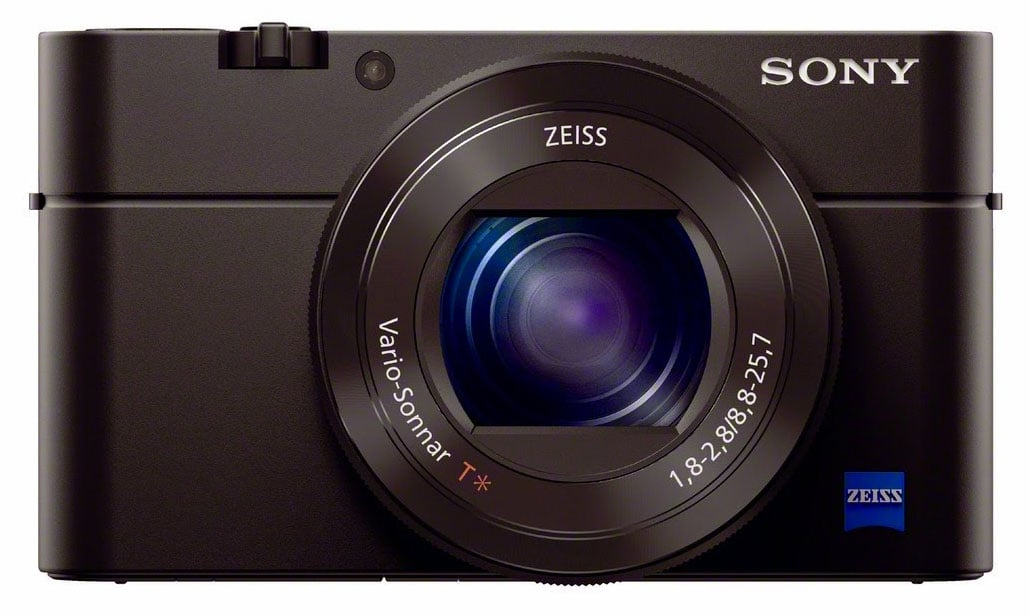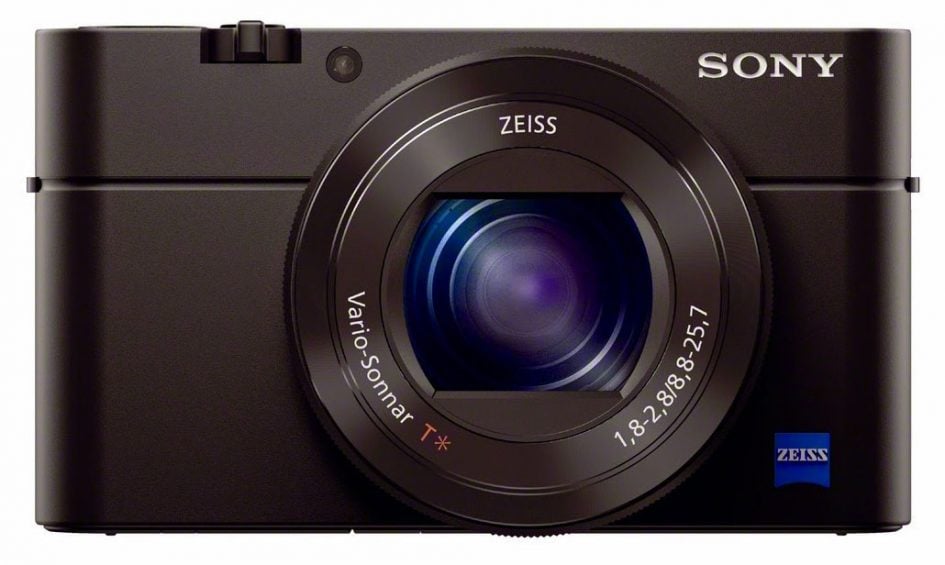
Sony Cyber-shot RX100 III review
-
-
Written by Gordon Laing
Verdict
In my opinion the Sony RX100 III is quite simply the best ‘pocketable’ camera for enthusiasts right now. The fact it manages to build significantly on what were already two very capable predecessors is all the more impressive.
With the original RX100, Sony squeezed a larger than average 1in-type sensor into a genuinely compact body. Sure the sensor wasn’t APS-C or even Micro Four Thirds in size, but it delivered far superior quality to existing point-and-shoot cameras while crucially keeping the body light and pocketable, something heftier rivals like the X100s and G1 X II can’t claim. Last year’s RX100 II added a tilting screen, hotshoe and improved the image quality. I liked it so much I bought one and carry it everywhere.
Now with the Mark III, the hotshoe may have gone, but amazingly Sony has found room for a popup electronic viewfinder, while also swapping the optics for a shorter but brighter and wider range, and further articulating the screen so it can now flip back to face the subject for self-portraits. The movie capabilities have been improved with higher-quality down-sampling, higher bit rates and zebra patterns. There’s also now a built-in ND filter which makes the brighter aperture lens more usable in daylight, and by supporting Sony’s downloadable apps, it’s possible to extend the functionality of the camera, including the smartphone remote control which is now more capable than the Mark II. It all adds up to an upgrade that’s more than just a refinement of the existing feature-set: the Mark III is a genuinely superior camera to those before it.

I admit to having low expectations for the viewfinder – at first it can be fiddly to popup and pull out for operation, and if the Sun is bright you may need to fashion a mini eye shield with any spare fingers. Both quickly become second nature though and the surprise is the viewfinder image is actually a lot bigger and more detailed than you expect. Sure, not as big as the finders on top-end mirrorless cameras, but it is as good as those on many mid-range models and that’s impressive for the body size.
Importantly though, the viewfinder is more than just a technical novelty. I found myself using it much more than I expected, especially given I was never tempted to mount the optional viewfinder accessory on my RX100 II’s hotshoe. The big difference here of course is that it’s built-into the body of the Mark III, so there’s no extra bulk to accommodate, nor extra money to spend – it’s just there when you need it.
When testing the RX100 III side-by-side with the Canon G1 X II, it felt bizarre to have the viewfinder built-into the smaller of the two bodies; I’d frequently look for it on the Canon and come away disappointed it didn’t have one built-in. Indeed this really is the killer feature of the Sony and I think all other enthusiast-class cameras from now on simply have to follow suit or fall behind.
Moving on, the next big feature is the new lens range: 24-70mm f1.8-2.8 versus 28-100mm f1.8-4.9 on its predecessors. Everyone complained about the slow aperture of the Mark I and II at the telephoto end, and indeed it counteracted the benefit of the bigger sensor compared to rival models with smaller sensors but brighter lenses. Sony couldn’t change the laws of physics, so sadly there’s no 100mm with a brighter focal ratio here. Instead the reach has been shortened to 70mm to attain f2.8, and as a sweetener the wide angle now captures a 24mm equivalent field of view compared to 28mm.
In practice it’s an interesting one to compare. On the main page of my review you’ll see the coverage compared, and certainly while the wider angle is very welcome, the fact is the older models could zoom-in 50% further at the telephoto end, giving them noticeably more reach and arguably a more useful general-purpose range.
For me though the really interesting comparison comes with their depth of field. At 70mm equivalent, the new Mark III lens is one stop brighter than the old Mark II, allowing it to deploy lower ISOs or faster shutters, while also delivering a shallower depth of field. But the older Mark II can of course zoom further into 100mm, where, if you stand back a little further, it can actually match the background blurring of the Mark III at 70mm f2.8. Meanwhile at the wide end, both models only offer f1.8 at their very widest focal lengths: 24mm for the Mark III and 28mm for the Mark II. Ironically this means for wide macro shots, the older Mark II can actually deliver slightly more background blurring thanks to matching the focal ratio at a slightly longer focal length. Confused? Sceptical? Just check out the lens section of my main review and you’ll see examples proving it – here’s a brief example below.
Sony Cyber-shot RX100 II Portrait at 100mm equiv f4.9 | Sony Cyber-shot RX100 III Portrait at 70mm equiv f2.8 | Canon PowerShot G1 X II Portrait at 120mm equiv f3.9 | ||
 |  |  | ||
full image | full image | full image |
The bottom line is the new 24-70mm f1.8-2.8 lens is supposed to be better at delivering a shallow depth of field, but if you can exploit the longer focal length of the earlier models, any benefit of the new lens in this regard is wiped-out. So the thing you should really be weighing up is whether you’ll find 24mm wide angle and built-in ND filter more useful than the reach of 100mm.
The new lens is at least good quality, and while my results pages show it and the Mark II sharing very similar levels of detail, I found my RX100 III sample images enjoyed slightly superior quality, especially in terms of edge and corner sharpness. Some of this could be down to the new BIONZ X processor, and while it may have only delivered a subtle benefit in still photo quality over the Mark II, I did notice improvements elsewhere.
First is with the Mark III’s continuous shooting, which may be no faster than the Mark II, but now seems happy to keep shooting while memory remains, instead of just for a small burst. I assume the BIONZ X has helped speed-up processing times, but the second aspect to benefit is the movie quality. Forget about encoding and bit rates for a moment and let me give you the good news that the full-frame downsampling of the Mark III delivers genuinely crisper and better-defined details than its predecessors. No, it’s not artifact-free, but it is visibly superior and that’s a nice upgrade. You can see a comparison below and find out more in the movie mode section of my main review.
Sony Cyber-shot RX100 II 100% crop from 1080 / 50p / AVCHD video | Sony Cyber-shot RX100 III 100% crop from 1080 / 60p / XAVC S video | |
 |  | |
| 100% crop taken from video grab | 100% crop taken from video grab Download the original file (Registered members of Vimeo) | |
Staying on the subject of video, the option to encode in XAVC S at almost double the best bit rate of AVCHD is very welcome indeed, as is the option of displaying zebra patterns in addition to focus peaking. Coupled with the 720 / 120p slow motion and upgrade in frame down-sampling, they make the Mark III a great movie camera.
But there are a number of annoyances with the Mark III and I may as well start with video. I really don’t like the way Sony only offers the choice of Continuous AF or Manual focus when filming videos. What about Single AF, which would allow you to tell the camera when to refocus with a gentle half-press of the shutter? Nope, as it stands if you want AF for movies, the camera decides when to focus and where to focus.
The removal of the hotshoe also means no chance to connect an external microphone for better quality audio, which is a shame since the high bit rate and 180 degree flip-out screen otherwise make the Mark III a perfect camera for video bloggers.
Also if the BIONZ X has enough processing muscle to downsample 20 Megapixel images to 1080p, surely it could also encode them at 4k? Maybe there’s other bottlenecks or heat issues, but I’m sure Panasonic will squeeze 4k into every camera it possibly can going forward, including any upcoming rival to the RX100 III. I’m also going to note the requirement of an SDXC card if you want to record XAVC S on the Mark III; it doesn’t matter how fast your 16 or 32GB cards are, they simply need to be SDXC, which normally means buying a 64GB card (or larger), or you won’t be recording in XAVC S.
Moving on, I like the way the screen now flips all the way up to face you, but I still curse Sony for not fitting a touch-sensitive panel. Yes I know there’s some who hate touch-screens, but Sony makes it so convoluted to reposition a manual AF are on its cameras, when others require nothing more than a single tap in the desired area. Indeed the process involved in repositioning an AF area is probably my biggest annoyance with the camera, and it’s revealing to note it’s something Panasonic solves with its touchscreens.
Finally, while I can normally give or take effects filters, I still find it odd that Sony doesn’t let you deploy the miniature effect for video, and annoying that all effects are greyed-out when shooting in RAW or RAW+JPEG. I much prefer the Olympus approach where you can shoot effects in RAW+JPEG and have the effect applied to the JPEG only.
Oh and while it’s nice to now be able to download apps to expand the capabilities of the camera, the RX100 III really does need to exploit a GPS log recorded by a smartphone sooner rather than later. Okay, whingeing out the way, it’s time for a few final comparisons before my final verdict.
Sony RX100 III vs RX100 II
 | ||
The camera that’s closest to the RX100 Mark III is of course the RX100 Mark II. Both share essentially the same body and controls, and in my tests much the same image quality too. There are of course a number of key feature differences though, mostly in favour of the newer Mark III.
In its favour, the Mark III sports a built-in electronic viewfinder that pops-put of the body; the older Mark II could fit a viewfinder accessory onto its hotshoe, but it adds to the size and cost. Both have 3in screens which can tilt vertically, but the Mark III’s can keep twisting round to face the subject which is great for self portraits or filming pieces to camera. The video quality of the Mark III is improved with greater detail in my tests, along with higher bit rates, zebra patterns, clean HDMI output and a slow motion 120fps option at 720p with sound. The wireless communications are also more sophisticated with the Mark III supporting greater smartphone remote control and the chance to upgrade its capabilities with downloadable apps.
The other big difference is the lens, although here it’s not so clear-cut. The Mark III has a 24-70mm f1.8-2.8 lens compared to 28-100mm f1.8-4.9 on the Mark II. This means the Mark III zooms wider, but loses out on telephoto reach. The shorter range is to implement a brighter focal ratio, and indeed at 70mm the Mark III’s lens is twice as bright as the Mark II. But don’t kid yourself into thinking this means achieving a shallower depth of field, as in my tests the Mark II could essentially match the background blurring if you zoomed it into 100mm and just stepped back a little. Something that’s definitely in the Mark III’s favour though is the built-in ND filter which can automatically deploy if desired – this allows you to shoot at open apertures in bright conditions without having to think about it and is a nice advantage over the Mark II.
In favour of the older Mark II are the longer zoom range and the presence of a hotshoe, allowing you to mount external lighting, a superior microphone or an optional viewfinder. Importantly the introduction of the new model has also seen the price of the Mark II become more affordable which makes it very tempting to those who don’t want or need the extra features of the new version. It’s still a great camera.
See my Sony RX100 II review for more details.
Sony RX100 III vs Lumix LX100
 | ||
Panasonic has always had an impressive line of compacts for enthusiasts, and the LX100 is its latest, going head-to-head with the RX100 III. Both models share a similar price tag in many regions, so it’s a case of weighing up the pros and cons very carefully.
In terms of lens range, there’s little in it. Both start at 24mm and end within 5mm of each other, and they share similar focal ratios too, with f1.8 at the wide end and f2.8 at the longer-end. In my tests the Sony was generally crisper across the frame, and its higher resolution sensor delivered greater details without compromising high ISO performance – at least below 3200 ISO.
The slightly bigger sensor and actual focal length of the LX100 though gives it an edge on blurring backgrounds on portraits. The LX100 can also focus much closer at the wide-end (3cm vs 5cm) and while they quote the same 30cm closest focusing distance at the telephoto-end, I found the Lumix could still get a little closer. This makes a big difference on the magnification you can achieve when shooting macro, and importantly the out-of-focus rendering on the LX100 was much better. The manual focusing experience on the LX100 was also superior. I should also note the Sony has a built-in ND filter whereas the Lumix does not – this may not be necessary for using bright apertures in daylight thanks to the LX100’s faster shutter of 1/16000, but the ND really helps with long exposure photography.
For composition, the LX100’s viewfinder is slightly larger than the RX100 III, especially when shooting in 16:9, but I personally prefer the look of the OLED panel on the Sony. Both share high resolution screens, neither of which is touch-sensitive, but the LX100’s is fixed in place, compared to the Sony’s which can angle up or down.
In terms of bodies, the RX100 III is noticeably smaller and lighter, and just about trouser-pocketable, whereas the LX100 most certainly isn’t. But conversely the LX100 has more to hold onto and feels more comfortable in your hands. The LX100 also has room for a flash hotshoe, although lacks the built-in flash of the RX100 III. Both have full manual control, but the Sony employs a PASM mode dial compared to dedicated dials for the shutter and aperture on the Lumix. I personally like the look of all the analogue dials, but prefer the control of a PASM system as I often work outside the normal shutter range. I should also mention the Sony can be charged over USB whereas the LX100 requires the separate AC charger.
In terms of movies, the LX100 boasts 4K recording which in my tests genuinely captures a lot more detail than 1080p, and Panasonic even lets you grab still photos from it during playback in-camera. But the RX100 III counters with 720p slow motion at up to 120fps.
Both have Wifi with smartphone remote control. The LX100 supports GPS tagging, but the RX100 III supports full exposure control and downloadable apps.
That’s all I’m mentioning for now, but you get the picture – there’s a lot to weigh-up and no definite leader. A lot will come down to size and whether you need something pocketable. Others will be influenced by the style and controls. The desire for 4K video is another, and now you know about the differences in macro, that could be a factor too. Interestingly though if you were hoping one would be decisively better than the other in terms of all-round image quality, you’ll be disappointed as there’s pros and cons to both.
See my Panasonic Lumix LX100 review for more details.
Sony RX100 III vs Canon G7X
 | ||
Canon’s G7X is the most obvious rival to the Sony RX100 III as both share essentially the same body size and sensor within. There’s little to choose between them in photo and video quality, although pixel-peepers will notice the Sony is a bit sharper in the corners at 24mm and the Canon is a little crisper at longer focal lengths. The Sony is also less aggressive with its noise reduction, resulting in finer detail on in-camera JPEGs at high ISOs, but once I get to test RAW files I’m expecting the original data to be similar.
The first big difference is lens range: 24-70mm on the RX100 III vs 24-100mm on the G7X, obviously giving the Canon longer reach. The focal ratios are the same at the wide and longest ends, which means the Canon can deliver shallower depth of field effects at 100mm f2.8 compared to the Sony at 70mm f2.8. The Sony can focus a bit closer at the long end, but any benefit is counteracted by the longer focal length of the Canon – both are good for macro at both ends of the scale.
Next comes composition. Both have 3in tilting screens which can face the subject for selfies, but the RX100 III’s tilts down as well as up. Countering this is a 3:2 panel which fits the shape of native images on the G7X, displaying them larger than the Sony. The G7X’s screen is also touch-sensitive, allowing you to tap to reposition the AF area or touch to pull-focus during movies – a huge benefit in my opinion. But the Sony RX100 III features a built-in electronic viewfinder that’s actually quite respectable, and remember you can’t fit one as an accessory to the G7X, so if a viewfinder is important to you, the decision will already be made.
Indeed much of the decision between the G7X and RX100 III boils down to these three main features: longer zoom (with shallower DOF at telephoto) and touchscreen on the Canon vs built-in EVF on the Sony. But there’s loads of little things to weigh up too. In its favour the RX100 III has more powerful smartphone remote control, downloadable apps, much better NFC negotiation, deeper bracketing, an auto ND filter, zebra patterns, USB charging, slow motion 720p movies at 120fps, higher bit-rates for 1080p, faster continuous shooting, and a panorama mode. Meanwhile its favour, the G7X has faster and more confident focusing, a dedicated exposure compensation dial, presets designed for easy astrophotography, GPS tagging via the smartphone app, better control over AF during movies and slightly more effective stabilisation. You may also have a preference between the clickable lens ring on the G7X versus the smooth one on the RX100 III. And finally, the G7X is cheaper than the RX100 III.
Ultimately I can’t say one of these cameras is better than the other as it depends on your preferences on the features above, but having used both models extensively, I would be very happy with either.
See my Canon G7X review for more details.
Sony RX100 III vs Canon G1 X II
 | ||
Canon’s PowerShot G1 X Mark II is another high-end compact aimed at enthusiasts, and priced the same as the RX100 III it becomes a natural rival, although both models are quite different.
In its favour the G1 X II features a larger 1.5in type sensor which coupled with a lower resolution allows it to deliver lower noise at higher sensitivities, although at some focal lengths the RX100 III has a brighter aperture, allowing it to use a lower ISO and narrow the gap. The Canon boasts a longer optical range of 24-120mm compared to 24-70mm, allowing it to zoom almost twice as close as the Sony; Canon’s also ensured the lens remains quite bright at the long end, which allows the G1 X II to deliver shallower depth of field effects than the Sony, so long as both are zoomed to their maximum focal lengths.
Both cameras feature vertically-tilting screens which can flip up to face the subject, but Canon’s is touch-sensitive, allowing you to easily change the AF area with a single tap or pull-focus while filming movies. The G1 X II also sports two lens barrel control rings, a bigger grip to hold onto and a hotshoe for mounting flashguns or the optional viewfinder. The movie mode also lets you apply a miniature effect if desired.
In its favour, the RX100 III features a built-in viewfinder, superior quality video with more detail, higher bit and frame rates, slow motion options, much more sophisticated smartphone remote control along with the chance to download apps into the camera, battery charging via USB (although I know some will prefer the traditional mains charging of the Canon), faster burst shooting (roughly twice as fast), and while both feature built-in ND filters, Sony can deploy its automatically whereas Canon’s requires you to choose when to use it or not.
The biggest difference though is their size, and for me this is the real deciding factor. The Sony is just about small enough to squeeze into most trouser pockets whereas the Canon is not, instead requiring a small bag, or a coat pocket. The Canon is heavier too and remember it doesn’t include a built-in viewfinder. On the other hand the Canon is easier to hold, especially if you have large hands, and the image quality for still photos is superior and the potential depth of field is shallower. Ultimately you have to think carefully about what features you want from a small camera, and crucially how small and light you’d like it to be.
See my Canon G1 X II review for more details.
Sony RX100 III vs Panasonic Lumix GM1
 | ||
Panasonic’s Lumix GM1 is one of the smallest interchangeable lens cameras around – indeed so small that when fitted with its kit zoom, or a pancake prime, it actually becomes comparable in size to small fixed-lens compacts like the RX100 series.
Both bodies are roughly the same size when viewed from the front and pack decent-sized sensors, 3in screens, 1080 movies with manual exposure control, built-in Wifi and focus peaking that works while filming video; they’re also roughly the same price, at least when comparing the GM1 kit.
In its favour, the Lumix GM1 is an interchangeable lens camera which can take any lens from the extensive Micro Four Thirds catalogue. Its sensor is slightly larger, allowing it to deliver lower noise levels when both it and the Sony are set to the same ISO value; in my tests the GM1 when fitted with a decent lens also resolved more detail despite its lower pixel count (16 vs 20). Its screen is touch-sensitive, allowing you to tap at the subject you’d like the camera to focus on for stills or during movies. There’s deeper seven-frame AE bracketing, powerful timelapse capabilities and the built-in Wifi works with a smartphone app that supports GPS tagging. The GM1’s autofocus also works under much dimmer conditions, making it more responsive both for city nightscapes and social interiors. Both cameras are quiet, but the GM1’s electronic shutter can be completely silent and also supports much faster shutter speeds up to 1/16,000 than the RX100 III. You can also apply the popular miniature effect to movies.
In its favour, the RX100 III has a body that’s 1cm thinner than the GM1 kit, allowing it to more easily squeeze into tighter pockets. It comes with a built-in viewfinder, whereas the GM1 doesn’t have one, nor even support one as an optional accessory. The RX100 III’s 24-70mm lens has a similar range to the GM1 kit zoom, but with a much brighter focal ratio of f1.8-2.8 vs f3.5-5.6. This makes it roughly two stops brighter across the entire range, allowing it to use lower ISOs under the same conditions and erode any advantage of the GM1’s bigger sensor (at least when it’s fitted with the kit zoom). It has a tilting screen which makes it easier to compose at high or low angles. The best quality video is 1080 at 50p or 60p, there’s a 720 / 120p slow motion mode, higher bit rates, a panorama mode and you can recharge the battery internally over USB.
The decision between them boils down to which features are more important to you. The Sony is definitely more pocketable and boasts a built-in viewfinder, brighter zoom as standard, a tilting screen and better video, while the Panasonic has the benefit of interchangeable lenses, a bigger sensor, faster AF that also works better in low light, and a touchscreen. For me, the GM1 really comes into its own when fitted with a small prime lens, like the Leica 15mm f1.7, where it will deliver superior quality stills to the RX100 III and better-looking shallow depth of field effects. But this in turn significantly raises the price of the camera above the Sony, and remember you still don’t have the option of a viewfinder. Ultimately though I’d be very happy with either model.
See my Panasonic Lumix GM1 review for more details.
Sony RX100 III final verdict
At the top of this page I described the RX100 III as the best all-round compact for enthusiasts right now. I realize there’ll be cries from those who love larger models like the Fujifilm X100s, but while the Fuji delivers better quality images, it’s simply not what I would describe as a compact camera: it’s much larger and heavier than the RX100 series, has a fixed lens, a fixed screen, inferior video and costs 50% more. Of all those things, it’s the size that’s most critical to me. Personally speaking a compact camera needs to fit in a relatively normal pocket, not demand a coat pocket nor a small bag. The RX100 series, despite becoming steadily thicker with every generation, can still do this, and of the cameras which are pocketable, I reckon the Mark III offers the most compelling feature-set and performance right now.
The challenge for Sony is to add features without compromising the dimensions, and thankfully this is an area where the company excels. It’s almost unbelievable to think they squeezed in a very usable electronic viewfinder with the only sacrifice being the hotshoe – which to be fair was partly used on the Mark II to support an optional viewfinder accessory, of course redundant on the III. The built-in viewfinder really is the major highlight on the Mark III and effectively renders models without one as looking a bit basic or even mean, especially Canon’s G1 X II which costs the same and is much heftier.
But the Mark III is more than a one-trick upgrade. The 180 degree screen is great for selfies, the video quality is now superior to any other compact I’ve tested, and while the lens may not deliver superior shallow depth of field effects to its predecessors, the wider 24mm equivalent coverage and built-in ND filter (which can deploy automatically), all make it a joy to use.
As noted above in more detail, there are some annoyances, chief of which is the way Sony continues to make you jump through hoops to move the AF area – a touchscreen could resolve this so easily. And while I don’t personally mourn the loss of the hotshoe, some means to connect an external microphone to record audio to match the great quality video would have made the Mark III a fantastic camera for video bloggers and interviewers.
So if you’re looking right now for a truly pocketable compact with much better quality and features than a typical point-and-shoot, then the RX100 III is the camera for you. Owners of the Mark I and Mark II versions should also consider upgrading if they’re happy with the form factor. As an existing RX100 II owner, I’m certainly tempted by the 24mm wide angle, built-in ND filter, more easily composed selfies, better quality video, and upgradable software via downloadable apps.
This is all why the RX100 III becomes the best overall compact I’ve tested for enthusiasts so far, and why it deservedly earns my Highly Recommended award. It also makes the earlier Mark II even more affordable for those who don’t need the built-in viewfinder. Sony continues to be the company which has a camera for everyone.
Good points
Bigger than average 1in sensor in compact body.
Useful 24-70mm equivalent range.
Bright f1.8-2.8 focal ratio and built-in ND filter.
Built-in electronic viewfinder.
Vertically tilting screen which angles 180 degrees.
Built in Wifi with NFC. Downloadable apps.
XAVC S video format offers 50Mbps high bit rate.
720p at 120fps with sound for slow motion.
Focus peaking and zebra patterns.
USB charging and optional remote cable.
Bad points
Too many button presses to reposition AF area.
Maximum focal length ‘only’ 70mm.
Shallow depth of field still a challenge.
Average stabilisation.
Smartphone app can’t tag GPS co-ordinates.
Screen isn’t touch-sensitive.
No hotshoe or microphone input.
No miniature effect mode for movies.
Needs SDXC card to support XAVC S movies.
No Single AF mode for movies, only CAF or MF.




